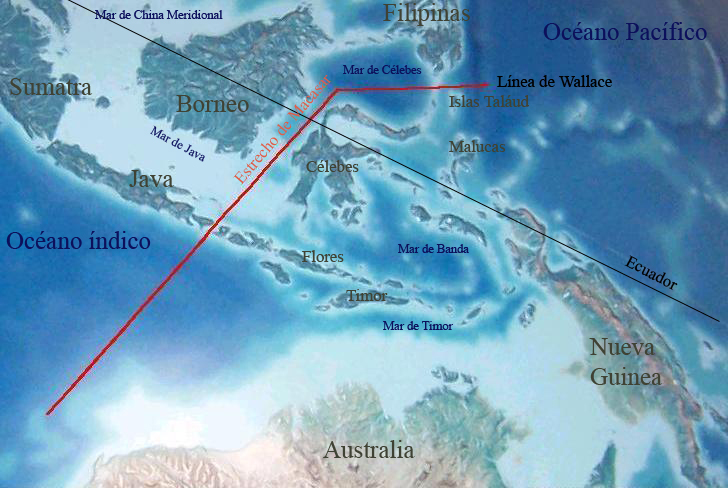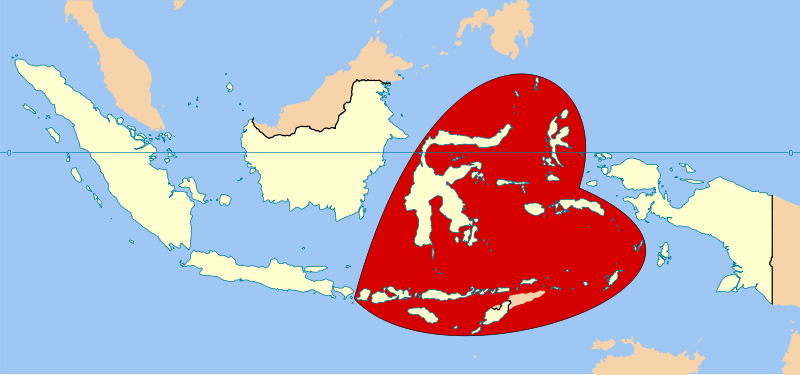Alfred Russel Wallace is most famous for two things:- for co-publishing the idea of evolution by natural selection with Charles Darwin in 1858, and for being the "father" of evolutionary biogeography. The best known of all Wallace's work in the latter field is his proposal of "Wallace's Line": a boundary separating the faunal regions of Asia (to the west of it) and Australasia (to the east). The line runs through the Lombok Strait between the islands of Bali and Lombok, then up between Borneo and Sulawesi, and from there continues northward to separate the Philippine island of Mindanao from the small islands of Sangir and Talaud that lie south of it. The significance of the line is that it identifies a major (though not entirely abrupt) faunal discontinuity: many major groups of animals (especially birds and mammals) found to the west of the line do not extend east of it, and vice versa.
 |
|
Wallace's Line divides the Australian and Southeast Asian fauna. The deep water of the Lombok Strait between the islands of Bali and Lombok formed a water barrier even when lower sea levels linked the now-separated islands and landmasses on either side [from Wikipedia]. |
Wallace first discovered this faunal discontinuity in June 1856 when he crossed the short stretch of sea separating the Indonesian islands of Bali and Lombok and was surprised to find that the bird communities were entirely different on the two islands. In 1859 he proposed the idea of the Line in what was to become his third most famous paper, "On the Zoological Geography of the Malay Archipelago" (http://people.wku.edu/charles.smith/wallace/S053.htm), the manuscript of which he sent to Charles Darwin. Darwin thought Wallace's paper was "admirable" and forwarded it to the Linnean Society of London, where it was read at a meeting on the 3rd November 1859. It was published in the Journal of the Proceedings of the Linnean Society: Zoology in 1860. The term "Wallace's Line" was coined in 1868 by Thomas Henry Huxley.
The concept of Wallace's Line stimulated much important biogeographical work and debate, and most people -if they have heard of Wallace at all- know him because of his famous Line.
This year marks the 150th anniversary of the reading of Wallace's paper which first proposed "the Line" and next year is the 150th anniversary of the paper's publication. What better way to mark the occasion than for Indonesia to publish a set of postage stamps commemorating Wallace's discovery of the Line and acknowledging the important part he played in documenting the animal fauna of that country. One stamp might feature an image of Wallace with a map in the background showing the location his Line, another could have a map showing Wallacea (see http://en.wikipedia.org/wiki/Wallacea), and further stamps in the set could feature old hand-coloured illustrations of some of the amazing animal species which Wallace discovered in Indonesia. If anyone reading this has appropriate contacts in the Indonesian postal service then please mention this idea to them! [Note that since writing this post a colleague in Indonesia has offered to contact the postal service to see whether they would be interested in producing a set of Wallace-related stamps].
For more information about Wallace's Line see:
http://discovermagazine.com/1997/aug/mrwallacesline1198
http://ngm.nationalgeographic.com/2008/12/wallace/quammen-text.html
http://en.wikipedia.org/wiki/Wallace_line
Also see this excellent programme by Prof. Aubrey Manning on YouTube: http://www.youtube.com/watch?v=rBRc4tLsYJE
 |
|
Wallacea, the heart of Indonesia. Wallacea encompasses islands which never had dry land connections to the main land masses of either south-east Asia or Australasia. Consequently it has few animals which find it difficult to cross stretches of open ocean (e.g. land mammals, land birds, or freshwater fish of continental origin) [from Wikipedia]. |

Add new comment